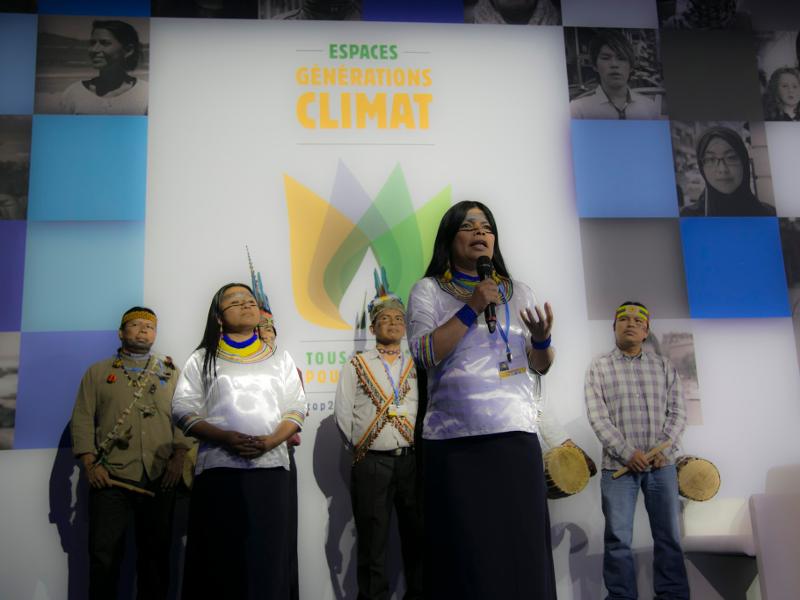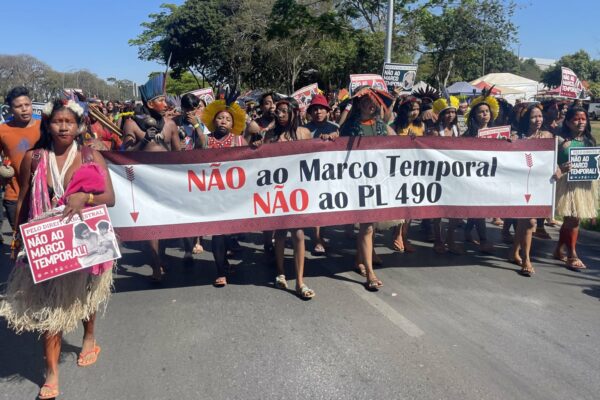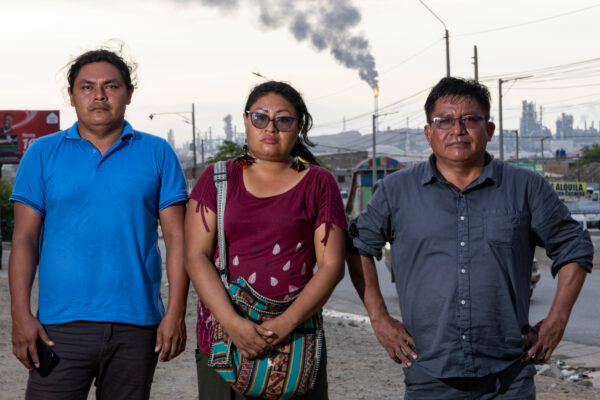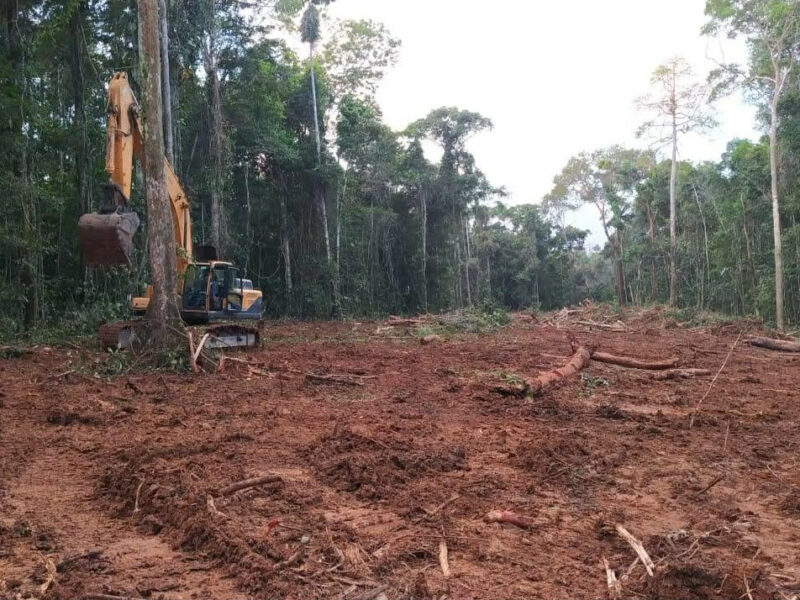
On December 12th, 195 nations signed the Paris Climate Accord, an agreement to limit CO2 emissions for the first time. In the days following, a debate has raged over whether the accord is a historic, unprecedented deal or whether it’s the product of a pro-business climate circus that sold out basic science and principles of justice.
So which is it? The complicated truth is that the Paris accord is both. It is indeed historic – a breakthrough landmark pact. And it’s nowhere near enough.
But the true hope out of Paris comes from the rising climate justice movement and the resilient voice of frontline indigenous peoples that made it impossible for government representatives to return home empty-handed.
Let’s start with the good.
With the failure to reach agreement at the COP15 in Copenhagen still fresh on everyone’s mind, the agreement commits nations to hold emissions to no more than 2°C, with an aspirational target of 1.5°C. If followed, that could help stave of the most serious impacts of climate change like arctic ice melt and corresponding sea level rise.
The agreement requires action by both developed and developing countries, and commits countries to an ongoing path of negotiations long into the future. While it is a global agreement, it is not a treaty per se, drafted as such on purpose to avoid the need for countries like the U.S. to have it domestically ratified by respective Congress or Parliament, a non-starter in the Republican controlled House in the U.S.
Some $100 billion per year was committed to the most vulnerable countries to help adapt to climate change, and there were major pledges by the large development banks to fund low carbon projects and renewable technology.
But perhaps the most important component of the agreement is between the lines. It sends a clear message to markets and companies that this is the path forward. The future will only consist of more stringent controls and regulations on emissions. If there was ever a moment to declare the end of fossil fuel era, this was it.
The agreement is also a sign to markets that renewables are the future, dirty fossil fuels the past, which could unlock much needed finance and investment for these to be dramatically scaled up. Of course, this also needs to be accompanied by an inevitable subsidy switch – terminating those for oil and gas, and increasing those for wind and solar.
Additionally, the idea that a ‘climate test’ ought to be applied to new projects and policies that facilitate an increase in CO2 emissions incompatible with Paris commitments – like the KXL pipeline, new oil and gas licensing of public lands, or reversing the oil export ban – now has real teeth and a mandate to back it up. This can only increase supply side strategies to keep fossil fuel reserves in the ground.
The Bad
But as the push to reach an accord continued, negotiators weakened the language by the minute. Petro-states objected to binding restrictions signaling the demise of their national industries. Annex 1 countries objected to the idea of compensation for nations that bear little responsibility for, but bear the brunt of, climate change impacts. And language around indigenous rights went from binding text to the non-binding preamble.
Ultimately, while the accord is legally binding, much of the reduction commitments are in fact pledges. It leaves each country to set its own target, comply or not with it, with no penalty mechanism if it’s not met. So while the 2°C degree goal and explicit mention of the more ambitious 1.5°C degree threshold is at long last a global recognition of where we need to go, the individual country pledges don’t get us anywhere close. In fact what has been pledged locks us into a world with predicted warming of at least 3°C degrees. The accord essentially kicks the hard negotiating down the road for later, as if we had the luxury of time on our side.
As Bill McKibben wrote in the New York Times, the accord would be a great deal if it were 1995. If it were the start, the floor, of what would be a two decades long negotiation of ever tightening emissions restrictions, strengthening rights protections, and common sense and action based on science and justice, we would be in decent shape by now.
Language throughout the Paris deal also enshrines false solutions such as REDD (Reduced Emissions from Degradation and Deforestation) that is touted by some as a way to protect forests as an essential carbon sink to help offset ongoing C02 emissions. However, REDD and other market based “solutions” that seek to offset emissions in the global north by paying to preserve forests somewhere in the south only allow or increase the toxic exposure for frontline communities of color who live next to refineries, industrial corridors, or other dirty fuel infrastructure from industries that would rather pay to pollute than clean up their operations. Meanwhile, communities in the south face well documented rights violations, land grabs, predatory legal contracts, and trinkets and beads style compensation for the services of their forests. Not to mention that several existing pilot REDD projects have become mired in carbon trading scandals.
The Ugly
Country negotiating teams and the resulting agreement seem content to take action to merely mitigate the worst impacts of climate change instead of addressing the roots of the climate crisis – unfettered capitalism, over-consumption, and insatiable growth. Governments are embracing business friendly stop gap measures like REDD and are unwilling to take the most effective action to curb CO2 emissions: keep fossil fuels in the ground.
And the ramifications are truly horrifying. For low lying island countries, it’s a death sentence, and it locks in a terrifying new reality of extreme weather, risking catastrophic polar ice melt and sea level rise, crop failure, drought, floods, mass migration, and war.
A New York Times article reports, “The research organization Climate Central found recently that 280 million people live on land that could eventually be submerged by the sea if warming were allowed to reach the higher[2°C] number. If it were kept to the lower target [1.5°C], that number would be cut by more than half, to 137 million people.”
That’s still 137 million people!
But already, where I live in Ecuador, the glaciers that top the avenue of volcanoes that can be seen from a clear day high in the Andean capital of Quito are rapidly shrinking, and expected to be gone by 2030. Throughout the country, rainy seasons never came, or dry seasons never left. Such dramatic changes to historic weather patterns have led to major crop failures, and left local indigenous and campesino communities wondering when, and at this point what, to plant.
The most concerning aspect of the climate agreement is the deeper disconnect that somehow humans are apart from, not part of, nor dependent on, nature. Nearly every nation objected to binding language on rights – indigenous, women’s, even human rights. In fact, rights language seemed so toxic to world leaders that several countries deliberately inserted it into sentences or paragraphs they wanted nixed.
So even though the sun is setting on the fossil fuel industry, it’s not going out without a fight. Inside the soulless labyrinth of temporary tent structures at the Le Bourget conference center was the Business Hub. Crawling with some of the world’s worst corporate actors and the big banks that finance them, they are battling to keep things business as usual and stay relevant, or maybe better yet, somehow be part of the ‘solution’. Companies and governments under the guise of pragmatic solutions to the climate crisis are all eagerly devising market based mechanisms, incentives, and ways in which they can make money off of the crisis. But why are we going to leave the fate of the planet in the hands of those who are most responsible for the current situation we’re in? We can’t.
While we are better off having the Paris accord than not, that this was the strongest agreement nations could come up with shows us that’s where world leaders are at, and that’s downright depressing.
People Power
What the Paris deal does means in practice is that industrial greenhouse gas emissions must stop by 2050 to hit the 2°C mark, and by 2030 to hit the 1.5°C level. Given world governments’ reluctance to making actual commitments that get us there, the work is, as always, up to all of us.
In the halls of the Le Bourget conference center, the rooms and pavilions of the Climate Generation civil society space, and yes, even on the streets and in the rivers – despite the ban on public events – indigenous peoples, front line communities, and activists made it clear that a rising climate justice movement was taking things into our own hands.
Much of the stage that was set for an agreement in Paris can be attributed to the globalization of a climate justice movement in support of frontline indigenous communities that have stopped major new industry infrastructure like the KXL pipeline, thwarted the opening of new drilling frontiers from the Arctic to the Amazon, put hundreds of thousands on the street in the largest climate march in history in New York last year, and saw thousands of actions around the world on Nov. 29th demanding action from world leaders, will continue to raise the bar and hold governments to account. The work to divest from the fossil fuel industry, eliminate oil, gas, and coal subsidies, shift markets away from dirty fossil fuels and towards renewables, strand assets at the wellhead, and protect the rights of those most vulnerable and vocal in defending the planet will only grow more powerful and widespread.
It can be confusing, and overwhelming, to make sense of climate change math and what it means for the future. For my son Camilo, who just turned five, the world he, his children, or grandchildren will inherit will be very different. Just how apocalyptic it will be depends much on what countries do in the immediate future following the Paris accord. And it’s us who will have to force the politicians, government, and industry to do what is needed. Not to disagree with Margaret Mead, but I think in order to change climate change, we need a large “group of thoughtful, committed citizens to change the world; indeed it’s the only thing that ever has.”













